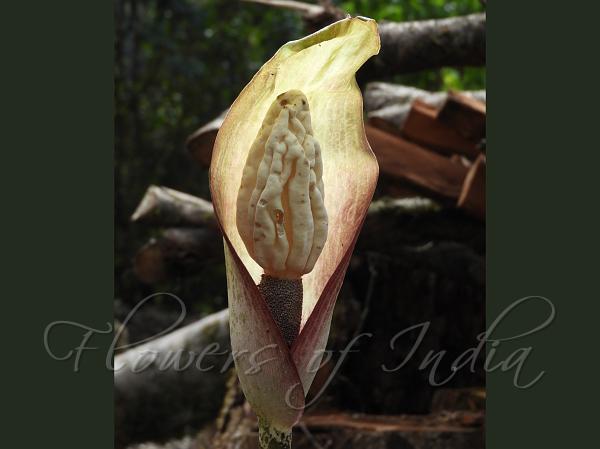|
| Burma Arum |
|

|

| File size | 372898 |
| Original date | 4/6/17 1:19 PM |
| Resolution | 3888 x 5184 |
| Flash | Flash did not fire, auto, red-eye reduction |
| Focal length | 26.9mm |
| Exposure time | 1/320s |
| Aperture | 5.2 |
| Focus Distance | |
| Metering Mode | Multi-segment |
| Camera make | NIKON |
| Camera model | COOLPIX B700 |
| Sensor type |
|
|
|
|
Photo: |
Botanical name: Amorphophallus kachinensis Family: Araceae (Arum family)
Synonyms: Amorphophallus bannaensis
Synonyms: Amorphophallus bannaensis
Burma Arum is a tuberous herb with tubers
depressed-spherical, 5-30 cm in diameter and 3-5 cm thick, skin
brownish. It is names for the Kachin state in north Burma. Leaf-stalk
is about 20 cm long, smooth, dirty white background with green to
reddish brown spots. There is a single leaf with leaflets elliptic,
6-9 x 2-3 cm, tip pointed-tapering. Flower-cluster-stalk is 24-80 cm
long. Spathe is more or less boat-shaped, slightly convolute at base,
8-29 × 7-14 cm, tip rounded or flat, green or greenish brown outside
with green spots or purplish stripes and spots; light purplish within,
with scattered, shallow, punctiform warts at base. Spadix is much
shorter than spathe, 6.5-18.0 cm long, female zone about 5 cm long;
male zone about 7.5 cm long; spadix-appendix about 15 cm high. Female
flowers are dense, each about 2.5 mm high; ovary sub-spherical, about
1.5 mm high. Male flowers are dense, each about 2 mm broad, stalkless.
Spadix-appendix is ellipsoid or ovoid with several irregular
longitudinal grooves or fissures. In Arunachal Pradesh, the corm and
seed is used as bait for rodents. Burma Arum is found in dense forests,
on limestone rocks, at altitudes of 1000-1500 m, from Arunachal Pradesh
to Laos, N Myanmar (Kachin State), N Thailand, China. Flowering:
April-May.
| Identification credit: Momang Taram | Photographed at Komkar, Upper Siang, Arunachal Pradesh. |
• Is this flower misidentified? If yes,